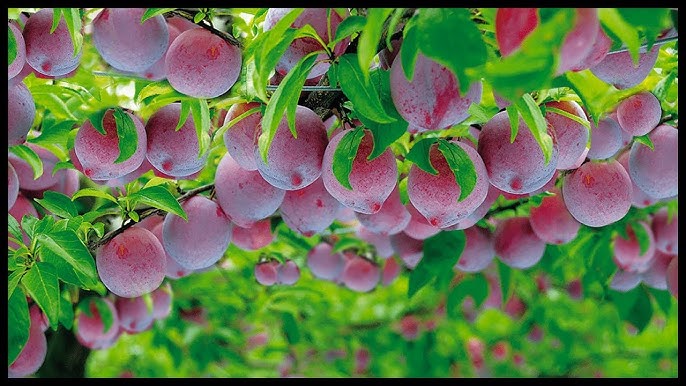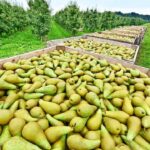Plums, known for their juicy and sweet taste, are becoming increasingly popular in Kenya. Grown primarily in the central highlands, these seasonal fruits flood the markets from December to early March. With rising demand both locally and internationally, plum farming presents a lucrative opportunity for farmers across the country. In this article, we take a look at the key aspects of plum farming in Kenya, including varieties, ecological requirements, and market potential.
Varieties of Plums Grown in Kenya
Several varieties of plums thrive in Kenya, each offering unique flavors and characteristics. The most common varieties include:
- Shiro: A yellow-skinned plum with sweet, firm flesh.
- Harry: Known for its sweet, red flesh and smooth skin.
- Methyl: Dark purple with a tart flavor, often used in processing.
- Cherry: A smaller variety with a bright red hue and sweet taste.
- Santa Rosa: One of the most popular, known for its juicy and sweet flavor with a reddish-purple skin.
Ecological Requirements for Plum Farming
Plums require specific ecological conditions to thrive, and Kenya’s highlands offer an ideal environment for their cultivation.
- Soil: Plums grow best in well-drained soils with a pH range of 5.5-6.5. Loamy soils rich in organic matter are ideal for healthy growth.
- Temperature: A moderate climate is perfect for plums, with optimal temperatures between 15°C and 24°C.
- Rainfall: Plums require well-distributed rainfall of above 1000mm annually. Irrigation can be used to supplement rainfall during dry spells.
- Sunlight: These fruits need exposure to direct sunlight for at least 8 hours daily for proper development.
- Altitude: Plums flourish at altitudes between 1700m and 2600m above sea level, making areas like Central Kenya and the Rift Valley ideal for their growth.
Land Preparation
Proper land preparation is crucial for a successful plum harvest. Plough the land early before the rainy season and remove all weeds to reduce competition for nutrients and water. Soil should be worked to a medium tilth to ensure good root penetration.
Planting and Propagation
Plums are primarily propagated asexually through grafting. The recommended rootstock for grafting is myrobalan seedlings, which are known for their compatibility with plum varieties and resistance to diseases.
The best time to plant is at the onset of rains to ensure good establishment. Planting holes should be large enough to accommodate the root system, with the standard planting spacing being 5m by 6m.
After planting, water the trees generously and apply mulch around the base to retain moisture.
Fertilizer Application
During the early stages of growth, well-decomposed organic manure can be applied to improve soil fertility. For young trees, a phosphorus-rich fertilizer helps promote strong root development. As the trees mature, nitrogen-based fertilizers can be used to support vegetative growth and enhance fruiting.
Pests and Diseases
Like other fruit trees, plums are susceptible to various pests and diseases that can affect yield.
Common Pests:
- Aphids: These small insects feed on sap, causing leaf curling and stunted growth.
- Stem borers: They bore into the stems and branches, weakening the tree.
- Mealy bugs: These pests suck sap from the tree, weakening it over time.
Common Diseases:
- Root rot: Caused by poorly drained soils, this can kill trees if not properly managed.
- Blossom wilt: A fungal disease that affects the blossoms, causing them to wilt and die.
- Brown rot: A fungal infection that causes the fruit to decay before it ripens.
- Scab and rust: These fungal infections cause blemishes on the fruit and can reduce the quality of the harvest.
Control measures include proper field hygiene, the use of resistant varieties, crop rotation, and the application of approved pesticides and fungicides.
Harvesting Plums
Plums are usually ready for harvest when the fruits are firm but supple. Gently apply pressure on the fruit to test its ripeness. The harvesting time depends on the variety, but most plums mature within 4 to 6 months after planting.
Farmers should be careful when harvesting to avoid damaging the fruit, which can affect its shelf life and market value. Harvesting can be done manually using hand tools or mechanically for larger farms.
Market for Plums in Kenya
Plums are highly nutritious, packed with vitamins, fiber, and antioxidants. Locally, they are sold in supermarkets, groceries, and open-air markets, especially during peak season from December to March. The average retail price for plums in Kenya ranges from Kshs 250 to Kshs 300 per kilogram, depending on the season and demand.
In addition to the local market, there is potential for exporting Kenyan plums to international markets, especially in Europe and the Middle East, where demand for fresh and dried plums is on the rise.
Plum farming in Kenya holds significant potential for farmers, particularly those in the central highlands. With the right practices, proper pest and disease management, and access to local and export markets, farmers can enjoy good returns from this increasingly popular fruit. Whether you’re a smallholder or a commercial farmer, investing in plums can be a rewarding venture.





